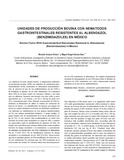Mostrar el registro sencillo del ítem
Unidades de producción bovina con nematodos gastrointestinales resistentes al albendazol (benzimidazoles) en México
| dc.rights.license | http://creativecommons.org/licenses/by-nc-sa/3.0/ve/ | |
| dc.contributor.author | Arnaud Ochoa, Ricardo | |
| dc.contributor.author | Alonso Díaz, Miguel Ángel | |
| dc.date.accessioned | 2012-09-12T16:21:19Z | |
| dc.date.available | 2012-09-12T16:21:19Z | |
| dc.date.issued | 2012-09-12T16:21:19Z | |
| dc.identifier.issn | 0798-2259 | |
| dc.identifier.uri | http://www.saber.ula.ve/handle/123456789/35877 | |
| dc.description.abstract | Los objetivos de este estudio fueron: i) diagnosticar unidades de producción bovina (UPB) con aislados de nematodos gastrointestinales (NGI) resistentes al albendazol (benzimidazoles), ii) conocer el uso de los antihelmínticos en las UPB e iii) identificar el género de los NGI resistentes. Se evaluaron siete UPB en la zona centro de Veracruz, México y en cada una se utilizaron becerros pre-destete con una edad y peso aproximado de 3 a 8 meses y de 50 a 150 kg de peso vivo (PV), respectivamente. Para detectar la presencia de NGI resistentes al albendazol se utilizó la técnica de reducción de huevos en heces. La cuantificación de huevos por gramo de heces se realizó mediante la técnica de McMaster modificada. Los animales se distribuyeron en dos grupos experimentales (n=15) con cargas parasitarias similares: 1) grupo testigo, 2) grupo tratado con un benzimidazol (5,0 mg de albendazol por kg de PV). A los catorce días postratamiento se tomó otra muestra de heces para determinar la carga de NGI y realizar un coprocultivo para la identificación de géneros de NGI. Se realizó una entrevista para obtener información sobre posibles factores de riesgo asociados a la resistencia. La prevalencia de unidades de producción con NGI resistentes al albendazol fue de 71,43% (5/7). No se identificaron factores de riesgo asociados a la resistencia de los NGI (P>0,05). Haemonchus spp fue el principal género de NGI identificado en todos los casos de resistencia. Se concluye que las UPB evaluadas en la zona centro del estado de Veracruz tiene una elevada presencia de NGI resistentes al albendazol. Se sugiere implementar medidas de bioseguridad en las UPB para evitar la difusión de aislados de NGI resistentes así como implementar buenas prácticas en el uso de los antihelmínticos. | es_VE |
| dc.language.iso | es | es_VE |
| dc.rights | info:eu-repo/semantics/openAccess | |
| dc.subject | Bovinos | es_VE |
| dc.subject | Nematodos gastrointestinales | es_VE |
| dc.title | Unidades de producción bovina con nematodos gastrointestinales resistentes al albendazol (benzimidazoles) en México | es_VE |
| dc.title.alternative | Bovine farms with gastrointestinal nematodes resistant to albendazole (benzimidazoles) in Mexico | es_VE |
| dc.type | info:eu-repo/semantics/article | |
| dc.description.abstract1 | The objectives of this study were: i) to diagnostic cattle farms (CF) with gastrointestinal nematodes (GIN) resistant to albendazole, ii) to know the use of anthelmintics in the CF and iii) to identify the genus of GIN resistant. Seven CF in the central region of Veracruz, Mexico were evaluated using calves with an age and weight live (WL) of 3 to 8 months and 50 to 150 kg. eggs reduction test was used to detect GIN resistant to albendazole and the quantity of eggs per gram of feces was performance with modified MacMaster test. According with the level of parasitism, animals were distributed to two experimental groups (n = 15): 1) control group, 2) treated group with albendazole (5.0 mg per kg of WL). Fourteen days aftertreatment, another sample of feces was taken to determine the level of gastrointestinal parasitism and to carry out cultures to identify the genus of nematodes. An interview was conducted to obtain information about possible risk factors associate to anthelmintic resistant. The prevalence of CF with GIN resistant to Benzimidazoles was 71.43% (5/7). There was not association between risk factors and GIN (P>0.05). Haemonchus spp was the main genus of GIN resistant to benzimidazoles. It is concluded that CF evaluated in the central region of Veracruz has a serious problem of GIN resistant to albendazole and it is suggested that the use of anthelmintics should be perform according with Medical Veterinary supervision. | es_VE |
| dc.description.colacion | 315-320 | es_VE |
| dc.description.email | alonsodm@unam.mx: alonsodma@hotmail.com | es_VE |
| dc.description.frecuencia | Bimestral | |
| dc.identifier.depositolegal | 199102ZU46 | |
| dc.subject.institucion | Universidad del Zulia (LUZ) | es_VE |
| dc.subject.institucion | Universidad de Los Andes (ULA) | es_VE |
| dc.subject.publicacionelectronica | Revista Científica | |
| dc.subject.seccion | Revista Científica: Medicina Veterinaria | es_VE |
| dc.subject.thematiccategory | Medio Ambiente | es_VE |
| dc.subject.tipo | Revistas | es_VE |
| dc.type.media | Texto | es_VE |
Ficheros en el ítem
Este ítem aparece en la(s) siguiente(s) colección(ones)
-
Revista Científica - 2012- Vol. XXII - No. 004
Julio - Agosto 2012


